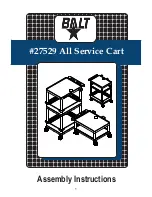
OPERATION ON SLOPS WARNINGS
1. Do not cross on slopes. Be sure to decrease speed and exercise caution.
2. Exercise caution when starting or stopping the machine on slopes.
3. As the loads become less stable on slopes, firmly secure the loads with ropes
4. As the machine becomes unstable depending on the condition of the road, keep the load to a minimum
5. As the view is obscured on slopes, keep the height of the load to a minimum
6. Never park the machine on steep slopes. Park the machine on flat ground, pull the brake lever and lock the
brake, and then turn the power off.
7. Do not change the direction or speed mode on steep slopes
8. Do not release the switch trigger on upward slopes. The machine may go in reverse and cause an accident.
9. Make sure that the remaining battery capacity is enough before operating on slopes. If the remaining battery
capacity is not enough, charge the battery or replace it with a charged one.
LOADING OBJECTIVE WARNINGS
1. Do not overload objects. When loading objects, be sure to follow the instructions and load limits in the manual.
2. Firmly secure the objects with ropes.
3. Load the objects within the carrier or bucket. If the objects protrude from the carrier or bucket, there is a risk of
accidents due to the objects falling or contact obstacles such as walls
4. Be sure that loaded objects are below eye level. If the load is too high, it is dangerous because the view is
obscured. Also, there is a risk of overturning and injury because the load is likely to be unbalanced.
5. Load the objects on the carrier or bucket evenly. If the objects are loaded unevenly, there is a risk of overturning
and injury because the load is likely to be unbalanced.
6. Before loading the objects or operating the machine, make sure that the lock lever is fully pulled down and
completely locked.
7. Load and unload objects on flat ground.
8. When lifting and tilting the carrier or bucket, hold the handles and frame firmly, and work in a stable posture.
BATTERY POWER TOOL USE AND CARE WARNINGS
1. Ensure the switch is in the off position before inserting battery pack. Inserting the battery pack into power tools
that have the switch on invites accidents.
2. Recharge only with the charger specified by the manufacturer. A charger that is suitable for one type of battery
pack may create a risk of fire when used with another battery pack.
3. Use power tools only with specifically designated battery packs. Use of any other battery packs may create a risk
of injury and fire.
4. When battery pack is not in use, keep it away from other metal objects like paper clips, coins, keys, nails,
screws, or other small metal objects that can make a connection from one terminal to another. Shorting the
battery terminals together may cause burns or fire.
5. Under abusive conditions, liquid may be ejected from the battery; avoid contact. if contact accidentally occurs,
flush with plenty of soap and water. If liquid contacts eyes, immediately seek medical help. Liquid ejected from
the battery may cause irritation or burns.
6. Avoid body contact with earthed or grounded surfaces, such as pipes, radiators, ranges and refrigerators. There
is an increased risk of electric shock if your body is earthed or grounded.
7. Do not expose power tools to rain or wet conditions. Water entering a power tool will increase the risk of electric
shock.
8. Do not abuse the cord. Never use the cord for carrying, pulling or unplugging the power tool. Keep cord away
from heat, oil, sharp edges or moving parts. Damaged or entangled cords increase the risk of electric shock.
9. When operating a power tool outdoors, use an extension cord suitable for outdoor use. Use of a cord suitable for
outdoor use reduces the risk of electric shock.
2




























